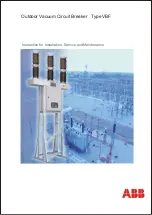
5-166
B30 BUS DIFFERENTIAL SYSTEM – INSTRUCTION MANUAL
FLEXLOGIC
CHAPTER 5: SETTINGS
5
Two bus differential zones can be configured. The zone is associated with its own bus differential protection element and
CT trouble monitoring element.
The bus differential zone is defined by providing the names of sources whose currents bound the differential zone (refer to
settings
BUS ZONE 1A SOURCE
to
BUS ZONE 1F SOURCE
).
The connection status of a circuit with respect to the protected bus is dynamically provided by FlexLogic operands
assigned to the
BUS ZONE 1A STATUS
to
BUS ZONE 1F STATUS
settings. The selected operand must be ON when the
corresponding circuit is connected to the bus. The operands are selected from the contact inputs that reflect positions of
particular circuit switches and/or breakers. If contact discrepancy filtering is needed, accomplish this using appropriate
FlexLogic to form a Virtual Output, representing the current circuit status. If a given circuit (feeder) is fixed to the protected
bus section and cannot be attached to any other bus section, then use the FlexLogic "ON" operand to represent fixed
circuit status.
The status signal is meant to exclude a given current from the bus zone if the circuit is connected to a different bus section
and its non-zero values upsets the current balance causing a spurious differential signal. Therefore, it is not required nor
recommended to use the position of the breaker to control the status signal of a given circuit. If the breaker is opened, the
circuit can remain included in the bus differential zone as the zero current values are measured and used when calculating
the differential signal. Dynamically excluding or including a given current during the breaker operation can cause
undesirable transients and race conditions for the relay algorithm.
If a given circuit cannot be connected to any other bus section different than the protected one, the FlexLogic constant
"On" is recommended for the status signal.
5.6 FlexLogic
5.6.1 FlexLogic operands
For flexibility, the arrangement of internal digital logic combines fixed and user-programmed parameters. Logic upon
which individual features are designed is fixed, and all other logic, from contact input signals through elements or
combinations of elements to contact outputs, is variable. The user has complete control of all variable logic through
FlexLogic. In general, the system receives analog and digital inputs that it uses to produce analog and digital outputs. The
figure shows major subsystems of a generic UR-series relay involved in this process.
BUS ZONE 1F STATUS:
Off
Range: FlexLogic operand
Summary of Contents for b30
Page 10: ...x B30 BUS DIFFERENTIAL SYSTEM INSTRUCTION MANUAL TABLE OF CONTENTS ...
Page 486: ...5 278 B30 BUS DIFFERENTIAL SYSTEM INSTRUCTION MANUAL TESTING CHAPTER 5 SETTINGS 5 ...
Page 616: ...iv B30 BUS DIFFERENTIAL SYSTEM INSTRUCTION MANUAL ABBREVIATIONS ...
Page 632: ...xvi B30 BUS DIFFERENTIAL SYSTEM INSTRUCTION MANUAL INDEX ...












































